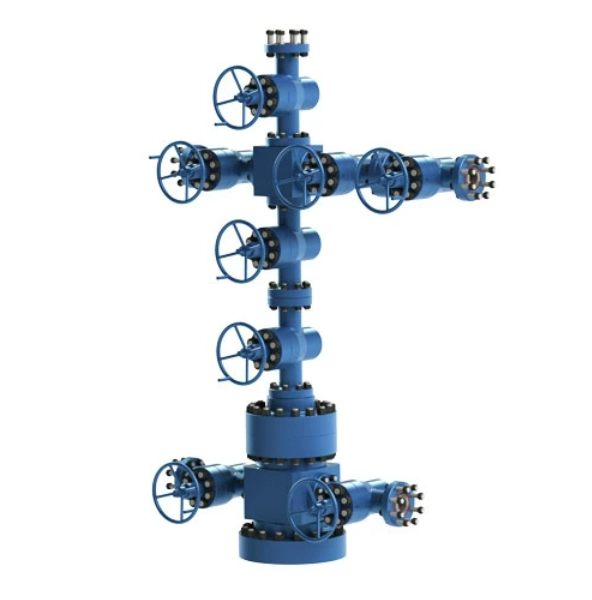
In the complex world of oil and gas extraction, many components work together to ensure safe, efficient, and controlled operations. Among these, the Wellhead Christmas Tree stands out as a critical surface control system that often draws curiosity, especially due to its festive-sounding name. But don't be misled—this "Christmas Tree" has nothing to do with holiday cheer and everything to do with serious industrial engineering.
What Is a Wellhead Christmas Tree?
The Backbone of Surface Pressure Control
A Wellhead Christmas Tree, often simply called a Christmas Tree, is a critical assembly of valves, spools, pressure gauges, and fittings installed on the surface of an oil or gas well. It sits directly atop the wellhead and serves multiple functions—most notably controlling the flow of hydrocarbons, injecting fluids, and managing well pressure.
The term "Christmas Tree" originated due to the visual resemblance of the valve arrangement to a decorated tree, especially in older configurations. However, don’t let the name fool you. This system is the nerve center of well operation and plays a crucial role in both onshore and offshore production environments.
Unlike the wellhead, which primarily ensures structural and pressure containment integrity at the casing and tubing interfaces, the Christmas Tree controls the production once the well has been completed. It allows operators to:
Open or shut the flow of hydrocarbons
Monitor well pressure and temperature
Inject chemicals or water
Control gas lift operations
Ensure safety during emergencies
Key Components of a Christmas Tree
A Breakdown of the Structure
Understanding the Christmas Tree means diving into its components, each with a specific role in well management. Below is a breakdown of the main parts typically found in a vertical Wellhead Christmas Tree:
| Component | Function |
| Master Valve | Controls the main flow from the well |
| Wing Valve | Allows flow to pipeline or testing facilities |
| Swab Valve | Provides access for well intervention tools |
| Choke Valve | Controls flow rate to manage production and reservoir health |
| Tubing Hanger | Supports and seals tubing inside the wellhead |
| Pressure Gauges | Monitor downhole and surface pressure |
| Crossover Adapter | Connects to flowlines or other production equipment |
Each component must be precisely engineered and pressure-rated to match the well's operating conditions, which can range from several hundred to thousands of psi.
Types of Wellhead Christmas Trees
Vertical vs. Horizontal vs. Subsea Designs
The Wellhead Christmas Tree isn’t one-size-fits-all. It’s tailored based on well type, environment, and operational strategy. Here are the three primary types:
1. Vertical Christmas Tree
This is the most traditional configuration, where the valves are arranged vertically above the wellhead. It’s commonly used in onshore and shallow water wells and is relatively easy to install and maintain.
2. Horizontal Christmas Tree
Primarily used in subsea environments, this design positions most of the valves on the horizontal plane. It offers better access for intervention tools and reduces the overall height, which is critical under water.
3. Subsea Christmas Tree
Designed specifically for deep-sea oil and gas wells, subsea trees are robust, corrosion-resistant, and remotely operated using ROVs (Remotely Operated Vehicles). Their complexity and cost are higher, but they are vital for deepwater exploration.
Each type comes with engineering considerations related to safety, temperature, pressure, and chemical exposure.
Operational Importance in Oil & Gas Wells
Why the Christmas Tree Is Mission-Critical
The Wellhead Christmas Tree is not just a mechanical structure—it is the control center for any completed well. It directly influences:
Well Integrity: By maintaining proper pressure levels and providing emergency shutoff capability.
Production Efficiency: By optimizing the flow rate using the choke and monitoring real-time performance.
Safety Management: With isolation valves that allow workers to safely perform maintenance or emergency shut-downs.
Environmental Protection: Preventing blowouts and controlling leaks, which are crucial in both regulatory and reputational contexts.
A malfunction in the Christmas Tree can lead to production halts, equipment damage, or worse, catastrophic blowouts. That’s why regular inspections, pressure testing, and system upgrades are non-negotiable.
Frequently Asked Questions (FAQs)
Clarifying Common Queries about Wellhead Christmas Trees
Q1: Why is it called a Christmas Tree?
The name comes from the arrangement of valves and fittings, which resembles a decorated tree, especially in older vertical designs.
Q2: Is the Christmas Tree part of the wellhead?
Technically, no. The wellhead supports the casing and tubing, while the Christmas Tree is installed above it to control production.
Q3: Can a Christmas Tree be reused?
Yes, depending on the condition and design. Trees can be refurbished or retrofitted for other wells.
Q4: What materials are used in a Christmas Tree?
High-grade stainless steel, Inconel, and other corrosion-resistant alloys, especially for sour wells (containing H₂S).
Q5: What is the lifespan of a Christmas Tree?
It varies by usage and environment but typically ranges from 10 to 25 years with proper maintenance.
Maintenance and Safety Considerations
Keeping the Tree in Good Health
Maintaining a Wellhead Christmas Tree involves both preventive and corrective measures. Common practices include:
Routine inspections using non-destructive testing (NDT)
Pressure testing of valves and seals
Lubrication and greasing of moving parts
Replacing worn-out chokes or seals
Regular function testing of emergency shutdown systems
In offshore and high-pressure/high-temperature (HPHT) environments, remote monitoring systems are used to reduce human exposure and ensure continuous performance. Safety protocols must align with international standards like API 6A, which governs wellhead and tree equipment.
Conclusion
The Wellhead Christmas Tree is far more than a cluster of valves—it’s the sophisticated gatekeeper of hydrocarbon production. It ensures operational control, production efficiency, and environmental safety, making it one of the most critical pieces of equipment in the petroleum industry. Whether it’s on land or miles below the ocean surface, the Christmas Tree plays a vital role in keeping energy flowing from beneath the Earth to the surface.





















